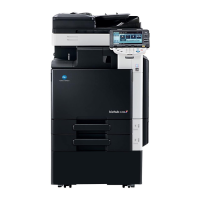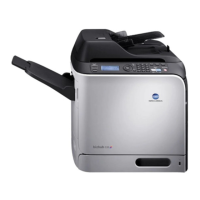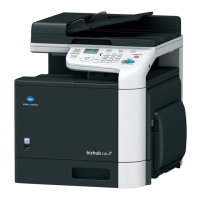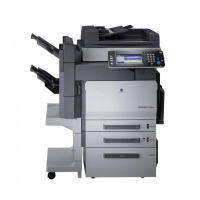17
17-64 bizhub C554/C454/C364/C284/C224
[OpenAPI Settings]
To display: [Utility] - [Administrator Settings] - [System Connection] - [OpenAPI Settings]
To use application software that communicates with this machine via OpenAPI, configure the OpenAPI set-
tings of this machine.
[Access Setting]
To display: [Utility] - [Administrator Settings] - [System Connection] - [OpenAPI Settings] - [Access Setting]
Select whether to enable access via OpenAPI from application software.
[Allow] is specified by default.
[SSL/Port Settings]
To display: [Utility] - [Administrator Settings] - [System Connection] - [OpenAPI Settings] - [SSL/Port Settings]
Configure the OpenAPI communication port and SSL communication settings.
Settings Description
[Access Setting] Select whether to enable access via OpenAPI from application software.
For details, refer to page 17-64.
[SSL/Port Settings] Configure the OpenAPI communication port and SSL communication set-
tings.
For details, refer to page 17-64.
[Authentication] Select whether to authenticate users accessing via OpenAPI.
For details, refer to page 17-65.
[External Application Con-
nection]
Specify whether to connect to external application software via OpenAPI.
For details, refer to page 17-65.
Settings Description
[SSL Setting] Specify whether to use the SSL for communication or not.
• [Non-SSL Only]: Only non-SSL communication is allowed.
• [SSL Only]: Only SSL communication is allowed.
• [SSL/Non-SSL]: Both SSL communication and non-SSL communica-
tion are allowed.
[Non-SSL Only] is specified by default.
[Port No.] If necessary, change the OpenAPI communication port number.
Normally, you can use the original port number.
[50001] is specified by default.
[Port Number (SSL)] If necessary, change the SSL communication port number.
Normally, you can use the original port number.
[50003] is specified by default.
[Client Certificate] Select whether to request a certificate from clients that connect to this ma-
chine. To authenticate clients, select [Enable].
[Disable] is specified by default.
[Certificate Verification
Level Settings]
To validate the certificate during SSL communication, select items to be
verified.
• [Expiration Date]: Confirm whether the certificate is within the validity
period. [Confirm] is specified by default.
• [Key Usage]: Confirm whether the certificate is used according to the
intended purpose approved by the certificate issuer. [Do Not Confirm]
is specified by default.
• [Chain]: Confirm whether there is a problem in the certificate chain (cer-
tificate path). The chain is validated by referencing the external certifi-
cates managed on this machine. [Do Not Confirm] is specified by
default.
• [Expiration Date Confirmation]: Confirm whether the certificate has ex-
pired. [Do Not Confirm] is specified by default.
• [CN]: Confirm whether CN (Common Name) of the certificate matches
the server address. [Do Not Confirm] is specified by default.

